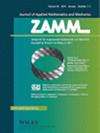矩形多孔通道中MHD非混相微极流体和牛顿流体流动的传热传质分析
IF 3.2
4区 工程技术
Q1 MATHEMATICS, APPLIED
Zamm-zeitschrift Fur Angewandte Mathematik Und Mechanik
Pub Date : 2023-07-27
DOI:10.1002/zamm.202200589
引用次数: 0
摘要
本文章由计算机程序翻译,如有差异,请以英文原文为准。
Heat and mass transfer analysis for MHD non‐miscible micropolar and Newtonian fluid flow in a rectangular porous channel
The aim of the present work is to examine the entropy production characteristics, thermal profile, and flow behaviour of two non‐miscible natures of Newtonian and micropolar fluids, which take place through a rectangular porous enclosure channel. The flow region is divided into two distinct porous zones of the channel and is subjected to a constant oriented magnetic field. The Eringen's micropolar fluid is taking place in the upper porous zone, whereas in the lower porous zone, the Newtonian fluid is flowing. The wall surface of a rectangular porous channel is isothermal, and the flow of immiscible fluid through a porous channel takes place because of a constant pressure gradient. No slip condition is imposed on the static walls and continuity of vorticity, velocity, shear stress component, thermal distribution, and thermal flux are prescribed at the interface. Here, the production of entropy due to fluid friction and thermal exchange for non‐miscible Newtonian and micropolar fluids is evaluated. The characteristics of various estimated parameters on thermal and flow properties, such as Bejan number distribution, flow velocity, entropy production, and thermal profile, are discussed. The obtained results show that entropy production is directly proportional to viscous dissipation and Reynolds number, whereas it has a reverse nature with micropolarity parameter, inclination angle parameter, and Hartman number. Our results corroborate with previous published results.
求助全文
通过发布文献求助,成功后即可免费获取论文全文。
去求助
来源期刊
CiteScore
3.30
自引率
8.70%
发文量
199
审稿时长
3.0 months
期刊介绍:
ZAMM is one of the oldest journals in the field of applied mathematics and mechanics and is read by scientists all over the world. The aim and scope of ZAMM is the publication of new results and review articles and information on applied mathematics (mainly numerical mathematics and various applications of analysis, in particular numerical aspects of differential and integral equations), on the entire field of theoretical and applied mechanics (solid mechanics, fluid mechanics, thermodynamics). ZAMM is also open to essential contributions on mathematics in industrial applications.

 求助内容:
求助内容: 应助结果提醒方式:
应助结果提醒方式:


